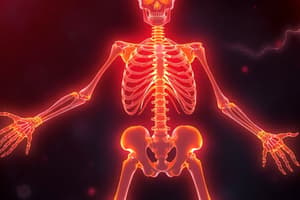Podcast
Questions and Answers
Composed of rhomboid cells
Composed of rhomboid cells
- Anticoagulant (correct)
- Procoagulant
- C
- D
Prostacyclin, TFPI, Protein C, Thrombomodulin(activates C and TAFI), tPA
Prostacyclin, TFPI, Protein C, Thrombomodulin(activates C and TAFI), tPA
- Anticoagulant (correct)
- Procoagulant
- C
- D
Nitric oxide, Heparan sulfate
Nitric oxide, Heparan sulfate
- Anticoagulant (correct)
- Procoagulant
- C
- D
VWF or Fibrinogen GPIb/IX/V
VWF or Fibrinogen GPIb/IX/V
VWF/Fibrinogen. GPIIb/IIIa
VWF/Fibrinogen. GPIIb/IIIa
Gp_. Collagen. V or VI or VII
Gp_. Collagen. V or VI or VII
Reversible
Reversible
These are zymogens that are converted to serine proteases. The last one is not converted to a serine protease, but a transglutaminase.
These are zymogens that are converted to serine proteases. The last one is not converted to a serine protease, but a transglutaminase.
Cofactors
Cofactors
Intrinsic pathway
Intrinsic pathway
Extrinsic pathway
Extrinsic pathway
Common pathway
Common pathway
Fibrinogen group
Fibrinogen group
Fibrinogen group is
Fibrinogen group is
Prothrombin group is
Prothrombin group is
Contact group is vitk and ca independent
Contact group is vitk and ca independent
Prothrombin group is
Prothrombin group is
Contact group involves 10 12 pk and hmwk, t or f
Contact group involves 10 12 pk and hmwk, t or f
Gwapong pangalan, sino sila. 4 letter.
Gwapong pangalan, sino sila. 4 letter.
Extrinsic or intrinsic, tenase that has 7, TF(3) phospholipid and ca. Activates 9 and 10.
Extrinsic or intrinsic, tenase that has 7, TF(3) phospholipid and ca. Activates 9 and 10.
Extrinsic or intrinsic. Tenase that has IXa, VIIIa, phospholipid and Ca. Activates 10.
Extrinsic or intrinsic. Tenase that has IXa, VIIIa, phospholipid and Ca. Activates 10.
Prothrombinase complex involves 5a 10a phospholipid and Ca. Activates prothrombin. T or f
Prothrombinase complex involves 5a 10a phospholipid and Ca. Activates prothrombin. T or f
Has a mean plasma concentration of 200-400 mgdL
Has a mean plasma concentration of 200-400 mgdL
Fibrinogen is the ultimate substrate of the coagation pathway
Fibrinogen is the ultimate substrate of the coagation pathway
Flashcards
Anticoagulants
Anticoagulants
Substances that prevent blood clot formation.
Major Anticoagulants
Major Anticoagulants
Anticoagulant molecules including prostacyclin, TFPI, Protein C, Thrombomodulin, and tPA.
Other Anticoagulants
Other Anticoagulants
Anticoagulant molecules including Nitric oxide and Heparan sulfate.
VWF Function
VWF Function
Signup and view all the flashcards
Fibrinogen Function
Fibrinogen Function
Signup and view all the flashcards
GpVI
GpVI
Signup and view all the flashcards
Platelet Adhesion
Platelet Adhesion
Signup and view all the flashcards
Coagulation Factors (Zymogens)
Coagulation Factors (Zymogens)
Signup and view all the flashcards
Coagulation Factors (Cofactors)
Coagulation Factors (Cofactors)
Signup and view all the flashcards
Intrinsic Pathway
Intrinsic Pathway
Signup and view all the flashcards
Extrinsic Pathway
Extrinsic Pathway
Signup and view all the flashcards
Common Pathway
Common Pathway
Signup and view all the flashcards
Fibrinogen Group
Fibrinogen Group
Signup and view all the flashcards
Fibrinogen Group Characteristics
Fibrinogen Group Characteristics
Signup and view all the flashcards
Prothrombin Group
Prothrombin Group
Signup and view all the flashcards
Prothrombin Group Factors
Prothrombin Group Factors
Signup and view all the flashcards
HMWK
HMWK
Signup and view all the flashcards
Extrinsic Tenase Complex
Extrinsic Tenase Complex
Signup and view all the flashcards
Intrinsic Tenase Complex
Intrinsic Tenase Complex
Signup and view all the flashcards
Prothrombinase Complex
Prothrombinase Complex
Signup and view all the flashcards
Tenase Complex Action
Tenase Complex Action
Signup and view all the flashcards
Contact group characteristics
Contact group characteristics
Signup and view all the flashcards



